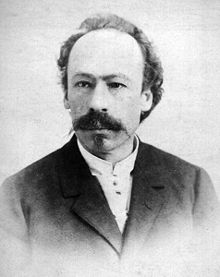Karol Olszewski
Karol Stanisław Olszewski (born January 29, 1846 in Broniszów , † March 24, 1915 in Kraków , then Austria-Hungary , now Poland ) was a Polish chemist , mathematician and physicist . Olszewski is best known because he and Zygmunt Wróblewski succeeded in the first liquefaction of air in 1883 .
Olszewski's father was a landowner and died a few months after Karol's birth in a peasant revolt. Karol Olszewski grew up as an orphan with relatives and attended school in Nowy Sącz (Neu Sandez) and Tarnów . From 1866 Olszewski studied physics and chemistry at the Jagiellonian University in Kraków. In 1872 he moved to the University of Heidelberg . There he did his doctorate in the same year without submitting a doctoral thesis, which was possible there at the time. Then Olszewski returned to the Jagiellonian University, where he was assistant to Emil Czyrniański . There Olszewski received his habilitation in 1873 , he became a lecturer and worked in the field of analytical and inorganic chemistry - initially from 1876 as an extraordinary professor and from 1891 as a full professor .
The fruitful collaboration with Zygmunt Wróblewski began in Cracow in 1882 when he came to the Jagiellonian University. After both had previously dealt with the liquefaction of gases, in 1883 they were the first to liquefy oxygen and nitrogen from the air.
When Olszewski heard of the discovery of X-rays in 1896 , he repeated Conrad Röntgen's experiments and took the first X-rays in what is now Poland.
Works
- About the liquefaction of oxygen, nitrogen and carbon dioxide , together with Zygmunt Wróblewski , in Annalen der Physik und der Chemie , 1883
literature
- Z. Kosiek: Olszewski, Karol Stanisław. In: Austrian Biographical Lexicon 1815–1950 (ÖBL). Volume 7, Verlag der Österreichischen Akademie der Wissenschaften, Vienna 1978, ISBN 3-7001-0187-2 , p. 228 f. (Direct links on p. 228 , p. 229 ).
Web links
Individual evidence
- ↑ a b Klaus Beneke: Karol Stanislaw Olszewski and the history of the liquefaction of gases (PDF; 744 kB).
- ^ Collegium Medicum Uniwersytet Jagielloński, Chair Of Radiology: History, from 19th to 21st century ( Memento of February 10, 2012 in the Internet Archive ).
| personal data | |
|---|---|
| SURNAME | Olszewski, Karol |
| ALTERNATIVE NAMES | Olszewski, Karol Stanisław |
| BRIEF DESCRIPTION | Polish chemist and physicist |
| DATE OF BIRTH | January 29, 1846 |
| PLACE OF BIRTH | Broniszów , Galicia |
| DATE OF DEATH | March 24, 1915 |
| Place of death | Krakow , Austria-Hungary |
